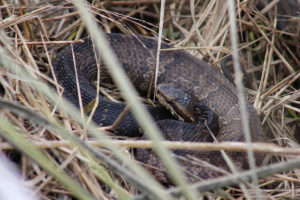The Cottonmouth (also known as the Water Moccasin) is a venomous pit viper (family Viperidae) native to the U.S. where it inhabits swamps, creeks, slow-moving streams, bogs, ditches, canals, and the shore of ponds and lakes. However, it may be found far from water as it travels between water sources in search of food and mates.
The cottonmouth is infamous for it’s defensive display of gaping ; opening it’s mouth wide, revealing a bright white (sometimes pinkish) interior. This is intended to startle and back off a would-be predator. The defensive display may also include jerky movements, tail shaking, and striking and biting those unwise enough to grab the snake.

Cottonmouth venom is rich with powerful cytotoxic venom that destroys tissue. Although deaths are rare, the bite can leave scars, and on occasion, require amputation. (wikipedia). All cottonmouth bites need to be treated by a toxicologist ASAP.
Prey is varied and can include almost anything they can fit in their mouth, including fish, amphibians, rodents, birds, reptiles (including other cottonmouths), and invertebrates. Studies show that the bulk of the cottonmouth diet consists of fish and frogs.
The cottonmouth was long considered one species (Agkistrodon piscivorus) with three subspecies. Recent DNA work has suggested that the Cottonmouth is actually two distinct species.
The cottonmouth is the source of dozens of urban legends and myths, and countless discussion, and sometimes heated debate. Please visit our facebook group Wild Snakes : Education and Discussion for more information.